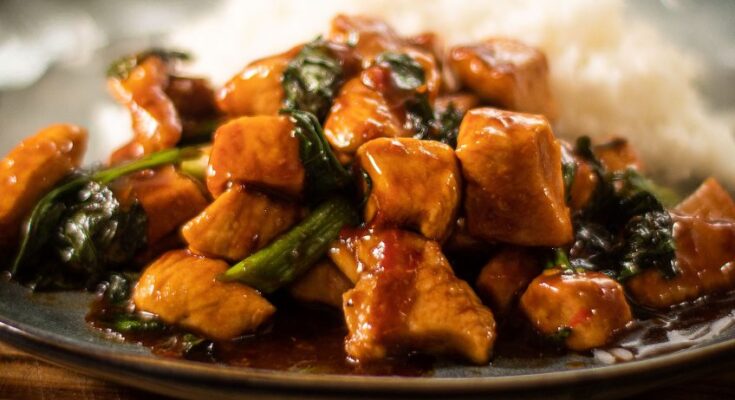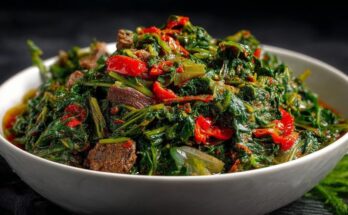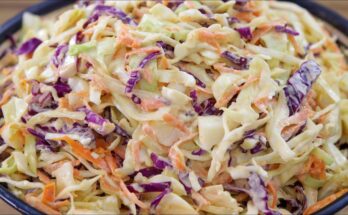Thai Basil Chicken Recipe: Thai Basil Chicken, or “Pad Kra Pao Gai,” is a bold, spicy, and incredibly flavorful dish that brings the street food flavors of Thailand straight into your kitchen.
With its sizzling garlic, fiery chilies, savory sauces, and aromatic Thai basil, this dish isn’t just delicious—it’s also quick to prepare and perfect for weeknight dinners.
Whether you’re new to Thai cooking or already love its vibrant cuisine, this guide will walk you through every step of the process.
What is Thai Basil Chicken?
Origins of Thai Basil Chicken
Thai Basil Chicken has its roots deeply embedded in Thai street food culture. It’s one of the most beloved and frequently eaten dishes in Thailand, often served as a fast, affordable, and satisfying meal. Vendors prepare it fresh to order, typically serving it over hot jasmine rice with a crispy fried egg on top. The combination of spicy, savory, and slightly sweet flavors makes it irresistible and comforting.
Key Characteristics of the Dish
What makes Thai Basil Chicken stand out is the unique use of holy basil—a herb known for its peppery and clove-like flavor. Unlike sweet basil, which is more common in Italian cooking, Thai basil brings an aromatic sharpness that perfectly balances the umami of the soy and oyster sauces with the heat from the chilies. The dish is typically made with minced or ground chicken, which absorbs the flavors well and cooks quickly, making it an efficient yet mouthwatering meal.
Ingredients You’ll Need
Main Ingredients
To make a traditional and authentic Thai Basil Chicken dish, here’s what you’ll need:
- Ground chicken – About 1 lb. (You can also use finely chopped chicken thighs.)
- Garlic – 4-6 cloves, minced
- Thai bird’s eye chilies – 4-6, finely chopped (adjust to taste)
- Vegetable oil – For frying
- Soy sauce – 2 tbsp (preferably light soy sauce)
- Oyster sauce – 1 tbsp
- Fish sauce – 1 tsp (optional but adds authentic umami)
- Sugar – 1 tsp (brown sugar works best)
- Water or chicken broth – 2 tbsp
- Thai holy basil leaves – 1 cup, loosely packed
Optional Add-Ons and Substitutions
- Fried egg – Traditional topping that adds richness
- Bell peppers or green beans – For added crunch and color
- Substitute meats – Pork, beef, or even tofu can be used
- Kaffir lime leaves – Adds citrusy aroma (optional)
Preparing Your Ingredients
Chopping and Measuring
One key to making great Thai food is prepping everything before you start cooking. Since the cooking process moves fast, having all your ingredients ready will make everything smoother and more enjoyable.
- Garlic and chilies: Mince these finely for even flavor distribution. Wear gloves if you’re sensitive to spice.
- Meat: If you’re not using pre-ground chicken, dice it very small or use a food processor.
- Basil: Only pluck the leaves, discarding tough stems.
Prepare your sauces in a small bowl ahead of time. Mix the soy sauce, oyster sauce, fish sauce (if using), sugar, and a splash of water or chicken broth to make a stir-fry sauce ready to pour in.
Tips for Freshness and Flavor
- Use fresh Thai basil if possible. It’s sold in many Asian supermarkets and sometimes labeled as “holy basil.” If unavailable, Italian basil can substitute, though the flavor will differ.
- Avoid pre-minced garlic or dried chilies—fresh ingredients make a huge difference.
- Make sure the chicken is not frozen or watery, as excess moisture can make the dish soggy instead of stir-fried.
Cooking Thai Basil Chicken – Step-by-Step
Step 1: Sauté the Garlic and Chilies
Heat a wok or large skillet over medium-high heat. Add 1-2 tablespoons of oil. Once hot, toss in the minced garlic and chopped chilies. Stir constantly for 30 seconds to 1 minute, until fragrant but not burned. The aroma at this stage is crucial—it forms the flavor base of the entire dish.
Step 2: Add the Ground Chicken
Add the chicken to the pan, breaking it up with a spatula or spoon. Stir-fry for 3–5 minutes or until the meat is no longer pink. Make sure to spread it out so it sears nicely rather than steaming.
Step 3: Add Sauces and Seasonings
Pour in your prepared stir-fry sauce (soy sauce, oyster sauce, fish sauce, sugar, and water/broth). Stir well to combine. Let the chicken absorb the flavors and cook for another 2–3 minutes until the sauce thickens slightly and evenly coats the meat.
Step 4: Toss in the Thai Basil
Finally, add your Thai basil leaves. Stir them into the hot chicken just until they wilt, which should take about 30 seconds. Turn off the heat immediately to preserve their fresh, herbal flavor.
Tips for the Perfect Thai Basil Chicken
How to Avoid Overcooking
When it comes to Thai Basil Chicken, timing is everything. The garlic and chilies should be sautéed just until fragrant—no longer than a minute—otherwise, they can burn and turn bitter. Similarly, the chicken should be cooked through but not overcooked to the point of dryness. Ground chicken cooks quickly, so keeping an eye on the texture is crucial.
If you’re using chicken breast, it can dry out faster than thigh meat. A trick to maintaining moisture is to stir-fry on high heat and avoid constant stirring. Let the meat sear slightly before flipping it. This not only locks in the juices but also adds a touch of caramelization that boosts flavor.
Balancing Flavors Just Right
Thai cuisine is all about balance—sweet, salty, spicy, and savory all playing in harmony. Taste your dish before serving and tweak the seasoning if necessary. Here’s how to adjust:
- Too salty? Add a pinch of sugar or a splash of water.
- Not spicy enough? Toss in a bit of chili oil or fresh chopped chili.
- Lacking depth? A little more fish sauce or oyster sauce can help.
Don’t forget the basil—it’s the star. Add it at the very end to keep its vibrant aroma intact. Cooking it too long can dull the flavor and color, so let it just wilt and you’re good to go.
Serving Suggestions
Best Sides to Pair With
Thai Basil Chicken is most commonly served with steamed jasmine rice. The fragrant, slightly sticky texture of the rice complements the saucy, spicy chicken perfectly. You can also try it with:
- Sticky rice for a more traditional touch.
- Fried rice if you’re looking to bulk up the meal.
- Cauliflower rice for a low-carb option.
For an added layer of indulgence, top the dish with a crispy fried egg (called kai dao in Thai). The runny yolk mixes beautifully with the spicy sauce, creating a rich and creamy mouthfeel.
Presentation Tips
Presentation might not be everything, but it definitely makes your dish more inviting. Here are a few simple tips:
- Plate the rice first in a bowl, then invert it onto a plate for a neat dome shape.
- Spoon the Thai Basil Chicken next to or partially over the rice.
- Garnish with a few fresh basil leaves or a slice of red chili for color.
- Serve with cucumber slices or a wedge of lime to cleanse the palate.
The final touch? Serve it in a rustic bowl or on a banana leaf for that true street food feel.
Nutritional Information
Calories and Macronutrients
A single serving of Thai Basil Chicken (without rice or egg) averages about 250–300 calories, primarily from lean protein and healthy fats. Here’s a general breakdown per serving:
| Nutrient | Approximate Value |
|---|---|
| Calories | 280 kcal |
| Protein | 26g |
| Carbohydrates | 6g |
| Fats | 16g |
| Fiber | 1g |
| Sugars | 3g |
Keep in mind, the numbers can vary depending on the amount of oil and sauces used, as well as portion sizes.
Healthier Alternatives
Looking to lighten up the recipe without sacrificing flavor? Try these healthy swaps:
- Use ground turkey or chopped mushrooms instead of chicken.
- Replace white sugar with coconut sugar or honey.
- Use low-sodium soy sauce to cut back on salt.
- For a low-carb version, skip the rice and serve with steamed veggies or in lettuce wraps.
Adding more vegetables like bell peppers, green beans, or carrots can also boost the fiber and nutrient profile, making it a more balanced meal.
Storing and Reheating
Refrigeration Tips
If you have leftovers, Thai Basil Chicken stores well in the fridge for up to 3–4 days. Store it in an airtight container to preserve the aroma and prevent other food smells from mixing in.
Pro Tip: Store the rice and chicken separately to prevent the rice from getting soggy.
Freezing for Meal Prep
Planning ahead? Thai Basil Chicken freezes beautifully. Let it cool completely before transferring it into a freezer-safe container or zip-lock bag. Label it and store for up to 2 months.
To reheat:
- Thaw overnight in the fridge.
- Reheat in a skillet over medium heat or microwave until hot.
- Add a splash of water or broth to bring back the moisture and revive the sauce.
FAQs about Thai Basil Chicken Recipe
What type of basil should I use?
Use Thai holy basil for the most authentic flavor. If you can’t find it, Thai basil or even sweet basil can work in a pinch, but the taste will be slightly different.
Can I use other meats instead of chicken?
Absolutely! Ground pork, beef, or turkey all work well. You can even use tofu or tempeh for a vegetarian version.
How spicy is Thai Basil Chicken?
It can be quite spicy, depending on how many chilies you use. You can always reduce the amount to suit your taste or add more if you like heat.
What’s the difference between Thai and sweet basil?
Thai basil has a peppery, anise-like flavor, while sweet basil is milder and commonly used in Western cooking. Thai holy basil has a clove-like aroma, which is most traditional for this dish.
Can I make this vegetarian?
Yes! Substitute the chicken with firm tofu or chopped mushrooms and use soy-based sauces. It still tastes amazing and keeps all the essential Thai flavors.
Conclusion
Thai Basil Chicken is more than just a quick stir-fry—it’s a deeply flavorful dish packed with culture, tradition, and spice. It’s fast, budget-friendly, and flexible enough for both novice and seasoned cooks. Whether you’re craving a bold new dinner idea or want to bring the vibrant energy of Thai street food into your home, this recipe delivers. Try it once, and it just might become your go-to weeknight meal.



